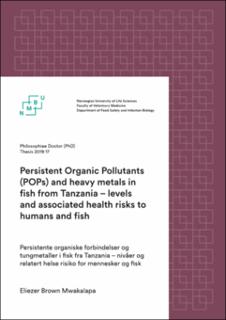| dc.contributor.advisor | Polder, Anuschka | |
| dc.contributor.advisor | Lyche, Jan Ludvig | |
| dc.contributor.advisor | Mmochi, Aviti John | |
| dc.contributor.author | Mwakalapa, Eliezer Brown | |
| dc.coverage.spatial | Tanzania | en_US |
| dc.date.accessioned | 2020-10-06T11:43:15Z | |
| dc.date.available | 2020-10-06T11:43:15Z | |
| dc.date.issued | 2019 | |
| dc.identifier.isbn | 978-82-575-1581-2 | |
| dc.identifier.issn | 1894-6402 | |
| dc.identifier.uri | https://hdl.handle.net/11250/2681342 | |
| dc.description.abstract | Diet is considered as the main route of exposure to pollutants such as persistent organic pollutants (POPs) and heavy metals to humans during lifetime. POPs and heavy metals are both persistent and can bioaccumulate in the tissues of organisms and biomagnify up in food chains. POPs are lipophilic and hence they can accumulate in lipid tissues of animal food stuffs, such as fish, eggs and meat. Therefore, they can accumulate considerable amount of POPs and heavy metals. POPs and heavy metals are potentially toxic to living organisms, such as humans and fish. The main aims of this study were to identify the occurrence and levels of persistent organic pollutants (POPs) and heavy metals in farmed, wild and imported fish in Tanzania and to increase knowledge on potential health risks related to consuming fish contaminated by POPs and heavy metals in Tanzania
The main findings from this study were that levels of POPs and heavy metals in farmed and wild fish from Tanzania varied widely between locations indicating exposure from various sources. The levels of DDTs and Pb were higher in wild fish compared to farmed fish in Tanzania. The ratio of p,p’-DDE to p,p’-DDT suggested both recent and historical use of DDT. The study revealed Pb levels above MLs in 100% of the studied fish from Tanzania.
In the imported fish from China, significant variation in levels and patterns of POPs and heavy metals were found between the individual fish. The study also suggests that importing commodities from China may be a pathway of introducing compounds like PCB-209 and HBCDD to Tanzania. Assessment of human health risk suggested possible adverse health effect due to DL-PCB-118 and -105 and As from consumption of tilapia from China. The assessment of fish health risk in this study revealed that PBDEs and Hg may pose possible adverse health effects in fish and may pose ecological health risk and threatens biodiversity. | en_US |
| dc.language.iso | eng | en_US |
| dc.publisher | Norwegian University of Life Sciences, As | en_US |
| dc.relation.ispartofseries | PhD Thesis;2019:17 | |
| dc.rights | Attribution-NonCommercial-NoDerivatives 4.0 Internasjonal | * |
| dc.rights | Attribution-NonCommercial-NoDerivatives 4.0 Internasjonal | * |
| dc.rights.uri | http://creativecommons.org/licenses/by-nc-nd/4.0/deed.no | * |
| dc.subject | Persistent organic pollutants (POPs) | en_US |
| dc.subject | Heavy metals | en_US |
| dc.subject | Aquaculture | en_US |
| dc.subject | Imported fish | en_US |
| dc.subject | Health risk | en_US |
| dc.subject | Tanzania | en_US |
| dc.title | Persistent Organic Pollutants (POPs) and heavy metals in fish from Tanzania : levels and associated health risks to humans and fish | en_US |
| dc.title.alternative | Persistente organiske forbindelser og tungmetaller i fisk fra Tanzania : nivåer og relatert helse risiko for mennesker og fisk | en_US |
| dc.type | Doctoral thesis | en_US |
| dc.subject.nsi | VDP::Agriculture and fishery disciplines: 900::Fisheries science: 920 | en_US |
| dc.source.pagenumber | 188 | en_US |
| dc.relation.project | NORAD: NORHED QZA-0485 TAN-13/0027 | en_US |

